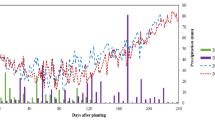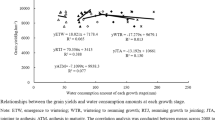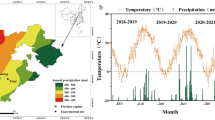Abstract
High evaporative demand and limited precipitation restrict the yield of winter wheat (Triticum aestivum L.) grown in the Loess Plateau of China under semiarid climatic conditions. Grain yield can be improved by effective water management practices. A 13-year field experiment was conducted at the CERN Changwu Agro-ecological Experimental Station of the Loess Plateau to determine optimal irrigation strategies under limited water supply and to develop relationships among grain yield (Y), seasonal evapotranspiration (SET) and water-use efficiency (WUE). The experiment consisted of five irrigation treatments and three blocks. Measurements included grain yield, soil water content at various depth intervals in the 0–3,000 mm layer, irrigation amount, and precipitation. Results showed that winter wheat grown in this area experienced serious water stress during critical growth stages for the no-irrigation treatment. The amount and timing of irrigation had an important effect on grain yield, but significant differences in yield were not observed between the three-irrigation and the four-irrigation treatments. Grain yield was linearly related (R 2=0.66) to SET, but differences in WUE were not significant for any of the treatments. The relationship between WUE and Y was best represented by a second order polynomial (R 2=0.65) consisting of a nearly linear portion between 1.5 and 5.0 Mg ha−1. Optimum water management of winter wheat in the Loess Plateau should consist of three 87.5 mm irrigations applied at stem elongation, booting, and anthesis.








Similar content being viewed by others
References
Al-Kaisi MM, Berrada A, Stack M (1997) Evaluation of irrigation scheduling program and spring wheat yield response in southwestern Colorado. Agric Water Manage 34:137–148
Chaudhary PN, Kumar V (1980) The sensitivity of growth and yield of dwarf wheat to water stress at three growth stages. Irrig Sci 1:223–227
Chen C, Payne WA, Smiley RW, Stoltz MA (2003) Yield and water-use efficiency of eight wheat cultivars planted on seven dates in northeastern Oregon. Agron J 95:836–843
Ehlig CF, LeMert RD (1976) Water use and productivity of wheat under five irrigation treatments. Soil Sci Soc Am J 40:750–755
FAO-UNESCO (1988) Soil map of the world: revised legend. (Soil bulletin no. 60) FAO, Rome
Hanks RJ (1983) Yield and water-use relationships: an overview. In: Taylor HM, Jordan WR, Sinclair TR (eds) Limitations to efficient water use in crop production. ASA, CSSA, SSSA, Madison, Wis., pp 393–411
Hatfield JL, Sauer TJ, Prueger JH (2001) Managing soils to achieve greater water use efficiency. Agron J 93:271–280
Hauser VL (1984) Neutron meter calibration and error control. Trans ASAE 27:722–728
Howell TA (1990) Relationships between crop production and transpiration, evapotranspiration, and irrigation. In: Steward BA, Nielson DR (eds) Irrigation of agricultural crops. (Agronomy monograph no 30) ASA, CSSA, SSSA, Madison, Wis., pp 391–434
Kamilov B, Ibragimov N, Evett S, Heng L (2002) Use of neutron probe for investigations of winter wheat irrigation scheduling in automorphic and semi-hydromorphic soils of Uzbekistan. In: Proceedings of an international workshop on conservation agriculture for sustainable wheat production in rotation with cotton in limited water resource areas, October 13–18, Tashkent, Uzbekistan
Kang S, Zhang L, Liang Y, Cai H (2002) Effects of limited irrigation on yield and water use efficiency of winter wheat on the Loess Plateau of China. In: McVicar TR, Rui L, Walker J, Fitzpatrick RW, Changming L (eds) Regional water and soil assessment for managing sustainable agriculture in China and Australia. (Monograph no. 84) Australian Centre for International Agricultural Research, Canberra, pp 105–116
Li F, Zhao S, Geballe GT (2000) Water use patterns and agronomic performance for some cropping systems with and without fallow crops in a semi-arid environment of northwest China. Agric Ecosyst Environ 79:129–142
Li F-M, Yan X, Li F-R, Guo A-H (2001) Effects of different water supply regimes on water use and yield performance of spring wheat in a simulated semi-arid environment. Agric Water Manage 47:25–35
Li Y, S Shu (eds) (1991) A comprehensive research on high efficient eco-economic system in Wangdonggou watershed of Changwu County (in Chinese). Sci-Tech Document Press, Beijing, China
Liang Y, Kang S, Liang Z (1998) Crop water production function and water supply model of winter wheat on Loess Plateau of China (in Chinese). Prog Geogr 17 (supplement):55–61
McCulloch DB, Wall T (1976) A method of measuring neutron absorption cross-sections of soil samples for calibration of the neutron moisture meter. Nucl Instrum Methods 137:577–581
Monteith JL, Unsworth MH (1990) Principles of environmental physics, 2nd edn. Edward Arnold, London
Musick JT, Porter KB (1990) Wheat. In: Steward BA, Nielson DR (eds) Irrigation of agricultural crops. (Agronomy monograph no 30) ASA, CSSA, SSSA, Madison, Wis., pp 597–638
Musick JT, Jones OR, Stewart BA, Dusek DA (1994) Water-yield relationships for irrigated and dryland wheat in the US Southern Plains. Agron J 86:980–986
Norwood CA (2000) Water use and yield of limited-irrigation and dryland corn. Soil Sci Soc Am J 64:364–370
Oweis T, Pala M, Ryan J (1998) Stabilizing rainfed wheat yields with supplemental irrigation and nitrogen in a Mediterranean climate. Agron J 90:672–681
Page AL, Miller RH, Keeney DR (1982) Methods of soil analysis. American Society of Agronomy, Madison, Wis.
SAS Institute (1998) SAS/STAT user’s guide: release 6.03 edn. SAS Institute, Cary, N.C.
Schaap MG, Leij FJ, Genuchten T van (2001) ROSETTA: a computer program for estimating soil hydraulic parameters with hierarchical pedotransfer functions. J Hydrol 251:163–176
Shao M, Yang W, Li Y (1988) A dynamic model of soil moisture availability to plants in the Loessial region. Chin Sci Bull 33:1470–1473
Shao M, Huang M, Zhang L, Li Y (2002) Simulation of field-scale water balance on the Loess Plateau using the WAVES model. In: McVicar TR, L Rui, J Walker, RW Fitzpatrick, L Changming L (eds) Regional water and soil assessment for managing sustainable agriculture in China and Australia. (Monograph 84) Australian Centre for International Agricultural Research, Canberra, pp 48–56
Sharma DK, Kumar V, Ashok P, Singh KN (1990) Effect of irrigation scheduling on growth, yield and evapotranspiration of wheat in sodic soils. Agric Water Manage 18:267–276
Shawcroft RW (1983) Limited irrigation may drop yield, up profit. Colo Rancher Farmer 37:35–38
Smith KA, Mullins CE (eds) (1991) Soil analysis: physical methods. Marcel Dekker, New York
Taylor HM, Jordan WR, Sinclair TR (eds) (1983) Limitations to efficient water use in crop production. ASA, CSSA, SSSA, Madison, Wis.
Vaux HJ Jr, Pruitt WO (1983) Crop-water production functions. In: Hillel D (ed) Advances in irrigation, vol. 2. Academic Press, New York, pp 223–255
Zhang H, Oweis T (1999) Water-yield relations and optimal irrigation scheduling of wheat in the Mediterranean region. Agric Water Manage 38:195–211
Zhang H, Wang X, You M, Liu C (1999) Water–yield relations and water use efficiency of winter wheat in the North China Plain. Irrig Sci 19:37–45
Zhu Z, Stewart BA, Fu X (1994) Double cropping wheat and corn in a sub-humid region of China. Field Crops Res 36:175–183
Acknowledgements
This work was financed by the Chinese National Natural Science Foundations (50079023), Innovation Project of the Institute of Soil and Water Conservation, CAS & MWR and CERN Changwu Agro-ecological Experimental Station of the Loess Plateau. Special appreciation is given to Minghang Guo, Daxue Dong, and Tinghui Dang for assistance with the field experiments.
Author information
Authors and Affiliations
Corresponding author
Additional information
Communicated by J.E. Ayars
Rights and permissions
About this article
Cite this article
Huang, M., Gallichand, J. & Zhong, L. Water–yield relationships and optimal water management for winter wheat in the Loess Plateau of China. Irrig Sci 23, 47–54 (2004). https://doi.org/10.1007/s00271-004-0092-z
Received:
Accepted:
Published:
Issue Date:
DOI: https://doi.org/10.1007/s00271-004-0092-z




